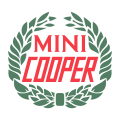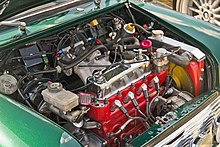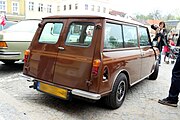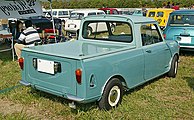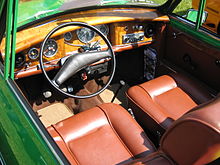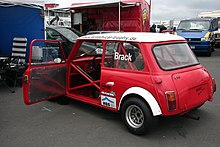Mini (car)
| Mini | |
|---|---|
|
Mini (1963)
|
|
| ADO15 / ADO20 / ADO50 | |
| Sales designation: | Austin Mini, Austin Se7en, AUTHI Mini, Innocenti Mini Minor, Innocenti Mini t, Leyland Mini, Leyland Mini Clubman, Morris Mini, Riley Elf, Rover Mini, Wolseley 1000, Wolseley Hornet |
| Production period: | 1959-2000 |
| Class : | Small car |
| Body versions : | Limousine , station wagon , pickup |
| Engines: |
Petrol engines : 0.85–1.3 liters (25.4–57.6 kW) |
| Length: | 3054-3401 mm |
| Width: | 1397-1410 mm |
| Height: | 1331-1384 mm |
| Wheelbase : | 2036-2138 mm |
| Empty weight : | 617-737 kg |
| successor | Mini Metro (ADO88 / LC8) |
Mini is the name of a passenger car model that was originally produced by the British Motor Corporation (BMC), the merger of the Austin Motor Company and the Morris Motor Company , and the successor companies British Leyland and Rover , which emerged through further mergers, from summer 1959 to autumn 2000 as well as by license partners (such as Innocenti (Italy), Authi (Spain) and IMA (Portugal)). Its front-wheel drive and the transversely installed four-cylinder engine in conjunction with the innovative compact body made it a milestone in the history of the automobile . The progressive concept was only gradually taken up by other automakers years later.
The name and stylistic features of this car have been borne by BMW's MINI brand vehicles since spring 2001 .
development
The Mini had a transversely installed front engine (the "A-engine", which had been developed for the Austin A30 in 1951, was used), under which the gearbox was flanged , which closed the engine at the bottom with an oil pan, which became the gearbox thus lubricated by the engine oil. The radiator was installed between the engine and the left front wheel and instead of steel springs, a space-saving rubber suspension was developed. Together with the small wheels (10 inches, 1959–1984) and the short body overhangs, the length of the vehicle could be limited to just over three meters, although there was space for four adults in the interior.
The Suez Crisis of 1956 was the impetus for the development of the small and economical automobile - the first energy crisis with clearly noticeable effects on the western world. The first vehicles manufactured in Birmingham were launched on August 18, 1959. The lasting success of the Mini was not in sight when Alec Issigonis drew his first sketches on a napkin or tablecloth. Originally, the car was marketed in parallel as the Austin Seven (also Austin Se7en ) and Morris Mini Minor (alluding to earlier models of the manufacturer, the Austin 7 and the Morris Minor), the cars were only sold as a separate brand "Mini" from 1969 onwards.
John Cooper applied his experience with tuning the A-series engine to the Mini and became the plant's in-house tuner. In public, a Mini is always equated with a Mini Cooper - it does not matter whether it is really one of the comparatively seldom built "real" Cooper, which (at least in the last few years) by white stripes on the bonnet and also can often be recognized by a different colored roof and compared to the standard models has a sometimes significantly higher performance and a different final translation (such as the SPi model).
On October 4, 2000, the last original Mini rolled off the production line, which was technically only modified in details during the 41-year production period. The best-selling British car had thus reached a total of 5,387,862 vehicles produced.
Technical data (1963/1964)
| Vehicle type: | Mini | Mini Cooper | Mini Cooper S. |
|---|---|---|---|
| Engine: | 4-cylinder in-line engine (front transverse) | ||
| Displacement : | 848 cc | 997 cc | 1071 cc |
| Bore × stroke: | 62.9 x 68.3 mm | 62.4 x 81.3 mm | 70.6 x 68.3 mm |
| Performance at 1 / min: | 25 kW (34 hp) at 5500 | 40 kW (55 PS) at 6000 | 51 kW (70 hp) at 6000 |
| Max. Torque at 1 / min: | 60 Nm (6.1 mkp) at 2900 | 72 Nm (7.3 mkp) at 3600 | 83 Nm (8.5 mkp) at 4500 |
| Compression: | 8.3: 1 | 9.0: 1 | 9.0: 1 |
| Valve control: | Bumpers and rocker arms, side camshaft | ||
| Carburetor: | 1 SU | 2 SU | 2 SU |
| Cooling: | Water cooling with pump and thermostat | ||
| Transmission: | 4-speed gearbox with stick shift (2nd to 4th gear synchronized), drive on the front wheels | ||
| Front suspension: | double wishbones | ||
| Rear suspension: | Swing arm (trailing arm) | ||
| Suspension: | Rubber suspension and telescopic shock absorbers front and rear | ||
| Body: | Self-supporting all-steel body with subframes at the front and rear | ||
| Track width front / rear: | 1206/1164 mm | 1206/1164 mm | 1233/1193 mm |
| Wheelbase : | 2032 mm | ||
| Wheel size: | 5.20-10 | 5.20-10 | 5.50-10 |
| Dimensions L × W × H: | 3060 × 1410 × 1350 mm | 3060 × 1410 × 1350 mm | 3060 × 1410 × 1355 mm |
| Empty weight (without driver): | 620 kg | 645 kg | 670 kg |
| Top speed: | 115 km / h | 138 km / h | 148 km / h |
| Price (Austin Mini): (→ value adjusted for inflation) |
5,780 DM (→ today 12,413 €) |
7,410 DM (→ today 15,913 €) |
10,525 DM (1967) (→ today 20,319 €) |
- Mini emblems
variants
Drive (series)
848 cc, 998 cc, 1098 cc and 1275 cc engines were mounted in the normal models. The Cooper-S versions were available with 970 cm³, 1071 cm³ and 1275 cm³ (always with two SU single carburetors ). The "normal" 1275 cc engine and the Cooper S 1275 cc engine have little in common except for the same cubic capacity. What is common to all Minis, however, is that the gearbox housing serves as an oil pan, is bolted directly to the engine from below and the gearbox shares the oil with the engine. This development was considered revolutionary in 1959 and, together with the transversely mounted front engine, ensured that so much car was possible on so little floor space. The Mini was the first car with a transversely installed four-cylinder in-line engine. Front-wheel drive with transversely installed engines has been in series production since the 1930s (including in the DKW F1 , Saab 92 , Lloyd, Goliath GP 700). In cars, unlike motorcycles, the concept of a shared oil circuit did not prevail; instead, in modern compact cars, the gearbox sits next to the engine and the drive shafts are of unequal length. This development goes back to the Autobianchi Primula from 1964. Due to the side-mounted radiator, the radiator grille on the front of the body is only a decorative element; the actual cooling air is sucked in through slots from the wheel arch by means of the fan wheel, which is continuously running, V-belt driven. In later compact cars, the radiator was placed in front of the engine and got an electric fan to ensure the cooling effect when there was no airflow. With the Mini, this detail, which still indicates the origin of the engine as a longitudinal construction, was retained until the end of the series. If only because there was no space for a radiator in front of the engine.
landing gear
In contrast to other passenger cars, the Mini has a suspension with conical rubber blocks instead of steel springs, developed by Alex Moulton , the later designer of the Moulton Bikes. It was very hard, but the Mini had a road holding that was hard to beat at the time. Because of the lightweight body, a subframe was installed at the front and rear, which carried the wheel suspension and engine. The wheels were suspended at the front on double wishbones and at the rear on longitudinal swing arms.
The short body variants were also available from 1964 to 1971 with the Hydrolastic , a rubber suspension with shock absorbers and a certain level compensation system with water hydraulics, in which the wheels on one side were connected to one another. Because of the alcohol added as frost protection, it was nicknamed " whiskey-soda springing".
The versions with a long wheelbase (Van or Estate) were only equipped with rubber suspension.
body
The Mini was built as a sedan with a short wheelbase, a station wagon / van and a pickup with a long wheelbase.
The Wolseley Hornet and the Riley Elf were sold as sedans with a longer notchback, modified front and higher grill .
From 1969 there was the Mini Clubman with a longer engine compartment and "angular" front, which replaced the more expensive Rileys and Wolseleys and was replaced in 1980 by the Mini Metro . The new shape came from Roy Haynes. The Clubman was only available as a sedan with a short wheelbase and a station wagon with a long wheelbase.
The long wheelbase versions (the station wagon with rear bench seat and side windows, the two-seater mini van without rear side windows and the pickup) were produced until 1981 and always had the exterior door hinges of the MK I / MK II series. The Clubman Estate, on the other hand, (station wagon with rear side windows and angular front) had interior door hinges and crank windows, as they were introduced at the same time for the sedans of the MK III series.
The Mini Clubman Estate not only has a different front mask than the station wagon, it also differs from the van / pickup in other ways.
The Countryman and Traveler station wagons with two rear doors were manufactured identically by Austin and Morris (GB). At BL Cars MINI IMA (Portugal) it was produced with a one-piece tailgate that opens upwards.
The Austin Countryman and the Morris Traveler were both also supplied with wood paneling on the sides and rear doors as "Woody".
The Mini Moke was originally designed as an army vehicle, but due to a lack of ground clearance, payload and performance, it was not built for the military. However, it then developed into a cult mobile of the 1960s, which was also due to the fact that Moke was seen in the James Bond film You Only Live Twice and in some episodes of the television series number 6 .
Prototypes with two drives
A lively competition broke out between Alec Issigonis and John Cooper to find out which team was the first to implement the idea of the bimotor mini after the first twin-engine Moke was created and was touted to the British Army as an all-wheel-drive vehicle. One of these Twini (for Tw inengine M ini ) drove with the Targa Florio . It was very fast, but used more cooling water than gasoline for the rear engine.
Mini technology in various kitcars
Due to the design with the two sub-frame, the engine / transmission unit and inexpensive dispenser vehicles many originated in England Kitcars with Mini technology such as the Mini Marcos, who - GTM and the yak.
Special models and foreign production
The Mini Cooper, the Mini Cooper S, as well as the Italian and Spanish Innocenti and Authi variants were available very early on.
In South Africa there was next to the normal models from 1967 to 1969 also the Wolseley 1000 and as its successor from 1969 to 1971 the Mark 3 (with notchback). The Minis assembled in Australia also differed in some features from their British counterparts.
Austin / Morris was contractually obliged to pay John Cooper £ 2 for every Mini Cooper sold. In 1969 the construction of the Mini Cooper (998 cm³) and that of the Mini Cooper S in 1972 were discontinued, instead there was only the Clubman 1275 GT with significantly less power as the strongest model.
A Cooper model was built by Innocenti in Milan until 1975 and also exported as the Innocenti Cooper 1300 with 64 hp from 1972. In Germany it was available from 1974 in the colors white, blue, red and green for almost 8,000 DM. In addition to the white or black roof, it was particularly characterized by its fender flares made of black plastic, with which other mini versions were later delivered. The Innocenti models also had triangular windows in the doors. In addition, Innocenti offered the Mini 1001 with a 48 hp engine, which, however, was not a sporty Cooper version.
The factory mini-convertible was added later, the first of which were manufactured in Germany.
In the ERA Mini Turbo, the engine and transmission from the MG Metro Turbo were used. The power was 94 hp. This required extensive changes to the body, the lubrication and cooling system and, of course, the suspension and braking system. The manufacturer specified an acceleration from 0 to 100 km / h in just under eight seconds.
A large number of special models such as the Mini Monte Carlo and Special and the anniversary Minis from 1979 (Mini 20 ), 1984 (Mini 25 and Mini Mayfair Sport ), 1989 (Mini 30 ), 1994 (Mini 35 ) and 1999 (Mini 40 ) expanded the model range.
Mini as a cult object


Movies
| year | main actor | title |
|---|---|---|
| 1964 | Peter Sellers | A shot in the dark |
| 1967 | The Beatles | Magical Mystery Tour |
| 1969 | Michael Caine | Charlie dusts off millions |
| 1978 | Bud Spencer | Flat feet in Africa |
| 1981 | Tony Barry | Goodbye pork pie |
| 1989 | Rowan Atkinson | Mr. Bean |
| 1996 | Gruschenka Stevens | The cold finger |
| 1997 | Bill Murray | Agent zero zero nothing |
| 2001 | Samuel L. Jackson | The 51st State |
| 2002 | Mike Myers | Austin Powers in gold stand |
| 2002 | Matt Damon | The Bourne Identity |
| 2003 | Charlize Theron | The Italian Job - chasing millions |
| 2007 | Rowan Atkinson | Mr Bean on vacation |
| 2007 | Ben Stiller | Flittered out after 7 days |
| 2010 | Anise Mohamed Youssef Ferchichi | Times change you |
| 2012 | u. a. Jason Mewes | Noobz - Game Over (Noobz) |
| 2016 | Robert De Niro | Dirty Grandpa |
Racing
The later three-time Formula 1 world champion Niki Lauda earned his first motorsport laurels in a few hill climbs in 1968 when he was 18 years old in a 1300 Mini Cooper S. The Mini was also the entry point for many other racing greats into the racing scene.
The Mini Cooper S (with the exception of a few very early models) always had two separate petrol tanks in the rear of the car - it was available as 970 cm³, 1071 cm³ and 1275 cm³ variants in order to utilize the displacement classes that were valid at the time.
The Mini won the Monte Carlo Rally four times in a row (1964–1967) , but in 1966 it was disqualified in favor of the French Citroën ID due to incorrect bulbs in the headlights - which, however, did not only increase sales in France this year let fast.
In early 1971 caused a certain Brian Culcheth on the Rallycross -distance Lydden Circuit (between Dover and Canterbury ) for attention. He drove a Mini that wasn't exactly acting like a Mini. On closer inspection it turned out that the Clubman with all-wheel drive was improved. The Special Tuning Department of BMC had the normal differential back away to a propeller shaft out which served to a mounted in the trunk additional differential of a Austin Healey Sprite drive. From this the power flow went via drive shafts from the Cooper S to the rear wheels. With a 1300 engine, which was equipped with a cross-flow cylinder head and Weber twin carburetors and developed around 120 hp, the 4 × 4 or 4WD mini was the sensation of the day, but was rarely in rallycross races after that to see. The Englishman David Angel brought the Clubman 4WD to Valkenswaard (near Eindhoven ) for the final rounds of the International Rallycross Championship of the Netherlands from August 1972 and was champion of its class at the end of the season. Because rallycross sport only allowed cars according to its Group 5 regulations from 1973 onwards for the later "adoption" by the FIA (in 1976) , the first generation of all -wheel-drive vehicles disappeared again from this autosport discipline at the end of 1972 also the only racing mini officially used by the BMC factory with a single engine and four-wheel drive.
The Mini is still often used in motorsport. Both in the historical series such as the "FIA European Challenge for Historic Touring Cars (FIA-TC'65)", the World Motorsport Association Fédération Internationale de l'Automobile and the "Historic Touring Car and GT Trophy", which the automobile club of Germany e. V. (AvD) advertises, many minis drive. In addition, stand Minis because of their low power to weight ratio for hill climbing at the start. There are also special series for the Mini in Germany with the “ British Car Trophy ” and in England with the “ Mini 7 ” and the “ Mini Miglia ”.
Mini drivers among themselves
Every year there is an international mini-meeting , the International Mini Meeting (IMM) , organized by a different mini club in a different country and held every five years on the occasion of the mini anniversary in Great Britain.
Models, technical changes
Type designation
In the vehicle documents, a distinction is only made between MK I and MK II, this is due to the fact that the models have only ever been updated and not subjected to a new type test.
| Type | Period | feature |
|---|---|---|
| MK I. | 1959-1967 | External door hinges, small rear window, smaller taillights, "mustache grill" |
| MK II | 1967-1969 | Larger rear window, larger taillights, angular grille with a top bar on the bonnet |
| MK III | 1969-1976 | interior door hinges with crank windows instead of the sliding windows |
| MK IV | 1976 - 08/1984 | rubber-mounted front subframe, (the last one with 10 "tires) |
| MK V | 08/1984 - 92 | Instruments in front of the driver (as with the Clubman), from now on 12 "tires and disc brakes in front (start of special model Mini 25) |
| MK VI | 1992-10/1996 | (SPi = TBi) Single Point Injection, regulated catalytic converter, Mini (53 HP), Mini-Cooper (63 HP) |
| MK VII | 10/1996 - October 4, 2000 | (MPi = XN) Multi Point Injection, with driver airbag, belt tensioners, side impact protection in the doors, front cooler, all models with 63 hp |
Timeline
| year | feature |
|---|---|
| 1959 | The Mini with 848 cm³ will be presented in April. |
| 1960 | The Countryman, Traveler, Van and Pick Up variants are presented. |
| 1961 | The first Mini Cooper with 997 cm³ appears on the English market. The models Wolseley Hornet and Riley Elf appear. |
| 1963 | The first Cooper-S with 1070 cm³ is built. |
| 1964 | Further variants of the Cooper-S with 970 or 1275 cm³ appear, the Cooper-S 1070 cm³ is discontinued. The 997 cm³ Cooper is replaced by the 998 cm³ Cooper. The moke production starts. |
| 1965 | In Italy the Mini Minor Mk I with 850 cm³ is launched. |
| 1966 | Moke production in Sydney, Australia and production of the 998 cc Cooper in Italy begins. |
| 1967 | Change from MK I to MK II. |
| 1968 | A revised and therefore fully synchronized gearbox is installed on all models. Moke production in England is discontinued. |
| 1969 | The 1275 Clubman GT (54 hp) initially with 10 "rustyle steel wheels, from 1972 with 12" Dunlop -Denovo safety wheels, appears, the 998 cm³ Cooper - like the models Wolseley Hornet, Riley Elf and Traveler / Countryman - discontinued. |
| 1970 | Change from MK II to MK III. |
| 1971 | The Cooper-S is discontinued. Innocenti starts production under license in Italy. |
| 1972 | A revised gearbox [Rodchange] with shift rods replaces the collar gearbox. The Minimatic with automatic gear is added to the product range. |
| 1973 | The [Rodchange] gearbox gets steel joints instead of rubber joints. The Spanish Authi models appear. |
| 1974 | The Innocenti 90 (998 cm³) and 120 (1275 cm³) appear on the Italian market. |
| 1976 | The front subframe is modified. This is now attached to the body with rubber mounts. |
| 1977 | Leyland Innocenti 90L (998 cm³) and 120L (1275 cm³) appear on the German market in May. |
| 1981 | The Metro engine [A +] is also introduced in the mini models, and Moke production in Australia is discontinued. The Innocenti 90 and 120 are discontinued. The successor models received a three-cylinder Daihatsu engine. |
| 1983 | The Van, Pick Up and Clubman variants are discontinued and Moke production in Portugal is started. |
| 1984 | The change from 10-inch to 12-inch wheels is necessary for all models due to the introduction of the front disc brake (8.4 "). |
| 1986 | The last mini with 850 cm³ is produced. |
| 1989 | For the 30th anniversary, a special Cooper model with 998 cm³ appears. |
| 1990 | Resurgence of the Cooper with 1275 cc. |
| 1991 | Moke production starts at Cagiva in Italy. |
| 1992 | The 1275 cm³ engine is produced with injection instead of the carburettor system (SPI). |
| 1993 | The last mini with 998 cm³ is produced, the moke production in Portugal and Italy is stopped. |
| 1996 | Model change from MK VI to MK VII (MPI). |
| 2000 | The last Mini leaves the assembly line in October. |
consumption
- 848 cm³ minis 4.5 l / 100 km
- 998 cm³ minis built up to 1988 6.0 l / 100 km
- 998 cc minis from year of construction 1988 (long geared 4th gear) 5.3 l / 100 km
- 1275 cm³ minis 7.3 - 14.0 l / 100 km depending on the carburetor and exhaust system
Due to the catalytic converter, all injectors (SPI and MPI) may only be operated with unleaded petrol, with the other variants the use of unleaded or (where available) leaded fuel is optional.
MINI - the successor
In 2001, the Mini was reissued as a MINI under the ownership of BMW . After the takeover of various English brands ( Rover , MG and Land Rover ) including the Mini model, of which only Mini now belongs to BMW, the production of the new Mini was prepared at the Rover Longbridge plant. After the new Mini had been largely developed by Rover, technical development was relocated to BMW in Munich shortly before the separation from Rover . The Rover 75 production lines in Oxford at the old Morris Cowley plant had to move to Longbridge, while mini production moved to Cowley. Cowley was then renamed BMW Works Oxford and modernized for production of the current Mini.
Mini remastered
The British car manufacturer David Brown Automotive has been offering the Mini Remastered since 2017 , the design of which is based on the Mini.
literature
- Hans J. Schneider: Mini technology + types. Delius Klasing, Bielefeld 2004, 2005. ISBN 3-7688-5783-2
- Peter Russek: Repair Manual Austin / Rover Mini. Bucheli, Zug 1995, 1996. ISBN 3-7168-1912-3
- David Vizard: Tuning the A-Series Engine. Haynes, Sparkford 2001. ISBN 1-85960-620-2
- John Brigden: Sporty Minis. Heel, Königswinter 1991. ISBN 3-89365-224-8
- Austin Seven 850 with front wheel drive. In: Motor Vehicle Technology 7/1960, pp. 274–276.
Web links
- Link catalog on Mini at curlie.org (formerly DMOZ )
- 50 years of Mini: Click through the most beautiful pieces from history. In: automobile.at.
- St. Pötener Mini Friends: The Mini. In: aon.at . Archived from the original on July 18, 2006 .
- Mini register.
Individual evidence
- ↑ a b c d e f Joel Kjellberg: Information about the MINI ( Memento from September 20, 2008 in the Internet Archive ) . In: Kjellberg's Mini Home. (Accessed April 20, 2007)
- ↑ Ryno Verster / Craig Watson: Mix & Match ( Memento from July 5, 2016 in the Internet Archive ), on: The Mini Experience .
- ↑ Keith Adams: Mini overseas: South Africa , on AROnline from November 29, 2013.
- ↑ Chuck Heleker: Minis Built for Export and Minis Built Outside of the UK at www.minimania.com of February 16, 2006



